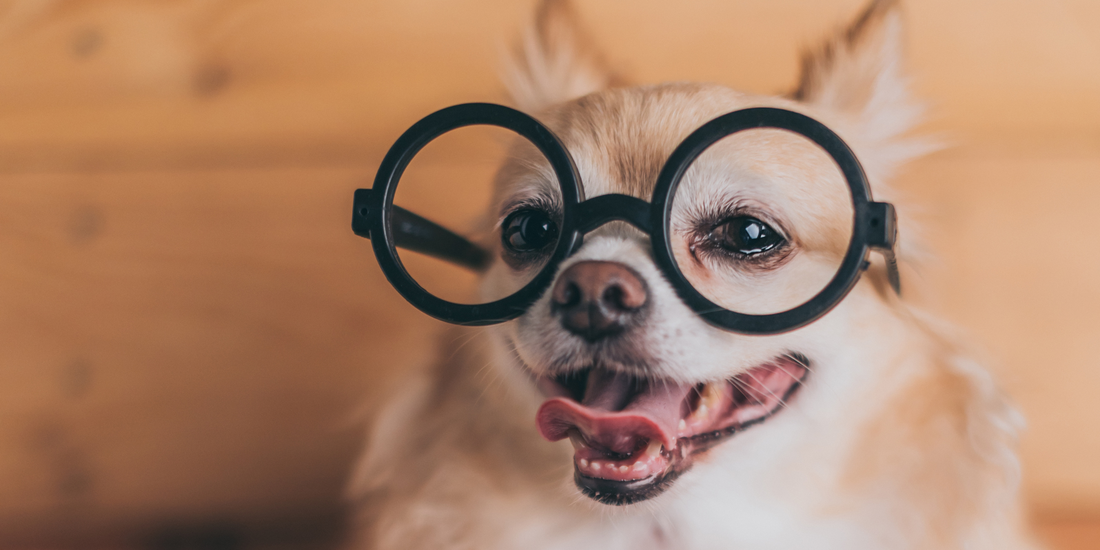Imagine looking down at your dog and being met with big, irresistible, heart-melting eyes staring back at you. Every dog owner or dog lover knows those puppy-dog-eyes all too well. Puppy dog eyes, which are full of emotion and admiration (and sometimes desire), may just get your dog a treat or some extra love. But there's much more to your pup's eyes than looking adorable. Here are five facts about dog eyes, dog vision and dog eyesight that you may not have known:
1. Dogs Can See Colors, Just Not As Many
There's an old rumor that says dogs see in black and white but that's actually not the case. Not only do they see black and white, but they also see shades of blue, yellow, green and gray. In addition, dogs can see red but it looks more dull and brown. So if your dog seems to prefer blue or violet toys, it's because those colors appear more vibrant.
The reason dogs don't see colors the way people do is because of the color receptors in their eyes. Canines have fewer color sensitive cone receptors, making them see essentially the same as someone who is red-green colorblind. Interestingly though, dogs are more in tune with sepias and pastels than humans are. For instance, they can accurately pick between different shades of gray that appear the same to humans.
2. Dogs Don't Have 20/20 Vision
Dogs don't have the sharpest of vision and are actually considered nearsighted. When people have 20/20 vision, they're able to see what the average person sees when standing 20 feet away. Dogs see more in the 20/60 to 20/75 range, which means that what they see at 20 feet is similar to what a human sees at 60 to 75 feet. So the clarity of their vision is a bit more grainy than humans', which is why they've evolved over the years to rely on other senses (especially smell) to make up for the limitations of their vision.
3. Dogs Have Better Peripheral Vision
While humans' peripheral vision allows us to see about 180 degrees of our field of view, dogs can see around 240 degrees. This is because their eyes sit farther apart, allowing them to see things we have to turn our heads to view. However, the degree of their peripheral vision varies between breeds and individual dogs. For example, sighthounds (like Greyhounds and Rhodesian Ridgebacks) have excellent peripheral vision because of their long, thin noses and the position of their eyes - with some even able to see up to 290 degrees.
4. Dogs Have Great Night Vision
You may have already known that dogs can see very well at night, but do you know how well? They can see around seven times better in low or dim lighting than humans can. This is in part because of their "tapetum." The tapetum is a reflective layer at the back of a dog's retina that bounces light around the back of the eye to give the dog more chances to collect as much light as possible. This helps them more easily recognize what's in front of them. In fact, the tapetum is what gives your dog that glowing-eye look in the dark - it's the light bouncing off the tapetum, through the pupil and back to your eye.
In addition to the tapetum, dogs have larger pupils and more light receptors called "rods" than humans, which also help them to see well in the dark. Larger pupils allow your dog to take in more light and the extra rods allow him or her to pick up and process even faint light.
5. Dogs Have a Third Eyelid
Yes, dogs have a third eyelid and no they're not aliens. The third eyelid, called a "nictitating membrane," is important to your dog's eyes for several reasons. First and foremost, it protects their eyes - dogs have a sensitive reflex where any sensation on the cornea will make their third eyelid go up. Another function of the third eyelid is to keep the eyes moist and produce tears. While the third eye isn't itself used for vision, it is important to maintaining your dog's eye health and therefore his or her eyesight.

